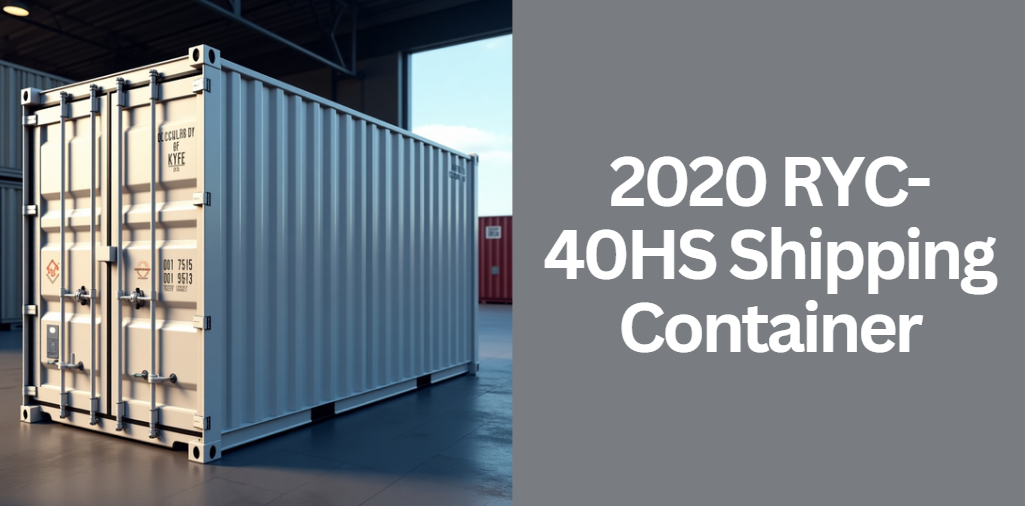2020 RYC-40HS Shipping Container: The Ultimate Comprehensive Guide
Shipping containers revolutionized international trade by standardizing the way goods are transported across the globe. The 2020 RYC-40HS Shipping Container is a specific model that exemplifies modern container design with its high‑cube structure, advanced quality checks, and versatile application options.
This guide explains the container’s background, technical details, market trends, and much more, making it your ultimate resource.
History and Background
Shipping containers have evolved significantly since their inception. Early designs were bulky and inefficient, but standardization, driven by international standards like ISO, transformed them into essential assets for global trade.
The 2020 RYC-40HS Shipping Container represents the latest evolution of the RYC series, a lineage known for durability and reliability. Manufactured in 2020, this model carries the legacy of its predecessors while incorporating modern improvements that meet today’s stringent quality and operational standards.
The manufacturer behind the RYC series has a rich history in container production, ensuring that each unit is built to last and perform under various conditions. The “2020” in its name may refer to its production year or an updated model iteration, symbolizing advancements in design, construction, and quality assurance.
Detailed Specifications and Features
Exterior and Interior Dimensions
The 2020 RYC-40HS Shipping Container is engineered to deliver consistent performance and reliability. Externally, the container typically measures around 40 feet in length, 8 feet in width, and between 9.5 to 9.6 feet in height.
These dimensions align with international standards for high‑cube containers, offering extravertical space compared to standard units. Internally, buyers can expect dimensions that allow for optimal storage capacity, with slight reductions due to the thickness of the container walls.
To illustrate, consider the following table summarizing typical dimensions:
| Specification | Measurement (Approx.) |
|---|---|
| External Length | 40 ft (12.19 m) |
| External Width | 8 ft (2.44 m) |
| External Height | 9.5 – 9.6 ft (2.90 – 2.93 m) |
| Internal Length | ~39.5 ft (12.04 m) |
| Internal Width | ~7.8 ft (2.38 m) |
| Internal Height | ~7.9 ft (2.41 m) |
Weight, Tare and Maximum Payload
Weight and payload capacity are critical factors when selecting a shipping container. The 2020 RYC-40HS Shipping Container is designed with a tare weight that ensures structural integrity while maximizing cargo capacity.
Typically, the container’s tare weight is balanced with a maximum payload that can reach up to 28,000–29,000 pounds, although exact numbers may vary slightly based on specific manufacturing standards and modifications.
Material and Construction Quality
Constructed from high-grade steel, the container offers excellent durability and resistance to the elements. Advanced welding techniques and rigorous quality controls (such as the IronClad Assurance® inspections) ensure that each 2020 RYC-40HS Shipping Container meets operational standards even if there is some cosmetic wear.
This robust construction makes it an ideal choice for both new buyers and those looking at government surplus or auction listings.
Door Specifications and Access Features
Access is key to functionality. The container is equipped with robust, secure doors that are designed to be weatherproof and ensure easy loading and unloading. In most cases, the door opening is designed to allow a width of approximately 2.34 meters and a height of around 2.28 meters, providing ample space for standard pallet and cargo dimensions.
Inspection, Condition and Quality Assurance
IronClad Assurance® Program
One of the standout features of the 2020 RYC-40HS Shipping Container is its certification under the IronClad Assurance® program. This quality assurance process involves thorough inspections by professionals who check for structural integrity, operational functionality, and overall condition. When you see a container backed by this assurance, you can be confident that it meets rigorous standards.
Evaluating Inspection Reports
Before purchasing, it is essential to review the container’s inspection report. These reports detail visible wear, any signs of rust, dents, or other potential issues. Buyers should differentiate between cosmetic flaws—which are often superficial—and structural problems that might affect performance. Regular maintenance tips and checklists can help you extend the lifespan of your container.
Maintenance for Longevity
Proper care can ensure that your 2020 RYC-40HS Shipping Container continues to perform optimally. Regular cleaning, rust prevention treatments, and periodic inspections can significantly enhance its durability and value over time.
Uses and Applications
The 2020 RYC-40HS Shipping Container is versatile, serving a wide range of applications:
- Standard Cargo Transport: Its robust construction and standardized dimensions make it ideal for intermodal shipping, where containers move seamlessly from ships to trucks to trains.
- Storage and Warehousing: With its secure and weatherproof design, it is commonly used for on-site storage of goods, equipment, and even vehicles.
- Innovative Conversions: Creative entrepreneurs have transformed these containers into offices, homes, pop-up shops, and even modular classrooms.
- Government Surplus and Auctions: Frequently, this model appears in government surplus auctions, where its durability and reliable performance are highly valued.
In summary, the container’s design ensures it can meet the demands of multiple industries, providing a flexible solution that adapts to different uses.
Market Analysis and Pricing Trends
Current Market Trends
Global market conditions, supply chain fluctuations, and regional demand influence container prices significantly. The 2020 RYC-40HS Shipping Container has enjoyed steady demand due to its robust features and versatile use. While prices can vary between new and used models, this particular model’s quality makes it a competitive option in both new purchases and auction settings.
Pricing: New vs. Used
New containers often command a premium because they come with minimal wear and advanced features, while used containers, despite cosmetic imperfections, provide a cost-effective alternative for many buyers. Here’s a simplified list to explain the pricing differences:
- New Containers: Typically priced between $4,500 and $7,900.
- Used Containers: Prices can range from $1,850 to $5,900, depending on condition and location.
Factors Affecting Prices
Several factors can influence the pricing:
- Condition: Structural integrity and cosmetic appearance.
- Location: Containers available near major ports may be priced lower due to reduced transportation costs.
- Modifications: Custom alterations or additional features can affect overall costs.
Comprehensive Buying Guide
When planning to purchase a 2020 RYC-40HS Shipping Container, it is crucial to follow a systematic buying process.
Pre-Purchase Considerations
Before making a purchase, evaluate your needs—whether for shipping, storage, or conversion—and determine your budget. Consider factors such as expected lifespan, the typical environment where the container will be used, and potential resale value.
Inspection Checklists and Due Diligence
Prepare a detailed inspection checklist that includes:
- Checking for rust, dents, and other visible damages.
- Verifying door functionality and seal integrity.
- Reviewing the inspection report from the quality assurance program.
Financing and Legal Considerations
Explore financing options available through dealers or auction platforms. Understand applicable taxes, permits, and legal requirements for container transport and installation in your region.
Transportation and Delivery Logistics
Plan for the logistics of transporting the container. Delivery costs can vary depending on distance and site accessibility, so ensure you have a clear understanding of these expenses before finalizing your purchase.
Customization and Conversion Options
One of the most exciting aspects of the 2020 RYC-40HS Shipping Container is its potential for customization. Many buyers convert these containers into mobile offices, homes, retail spaces, or even recreational vehicles.
Popular Modifications
Some of the common modifications include:
- Interior Insulation and Finishing: Adding walls, flooring, and ceiling treatments to create a comfortable living or working space.
- Electrical and Plumbing Installations: Equipping the container with essential utilities.
- Exterior Customization: Painting, adding windows, or modifying the doors for improved aesthetics and functionality.
Step‑by‑Step Conversion Guide
A typical conversion project might include the following steps:
- Planning: Determine your desired layout and necessary modifications.
- Inspection and Preparation: Clean and repair the container to ensure structural integrity.
- Installation: Add insulation, electrical wiring, and plumbing as needed.
- Finishing: Install interior finishes, furniture, and any other features to complete the project.
Case Studies and Real‑World Examples
Include examples of successful conversion projects, such as transforming a container into a modern office space or a compact home. These real‑world cases provide inspiration and practical insights for potential buyers.
Sustainability and Environmental Impact
The 2020 RYC-40HS Shipping Container is not just about functionality and durability; it also plays a significant role in sustainability.
Recycling and Reusability
Shipping containers are inherently designed for longevity and can be repurposed multiple times. This reuse reduces waste and the environmental impact associated with manufacturing new structures.
Energy-Efficient and Green Conversion Options
When converting containers into living or working spaces, consider using energy-efficient insulation, solar panels, and eco-friendly materials. These modifications can reduce your overall carbon footprint and provide a more sustainable living environment.
Compliance With Environmental Standards
Ensure that any conversion or modification projects comply with local environmental regulations. Adhering to these standards not only protects the environment but can also enhance the market value of your container conversion project.
Frequently Asked Questions
Q1: What distinguishes the 2020 RYC-40HS Shipping Container from earlier generations in the RYC series?
The 2020 model builds on previous designs by incorporating updated engineering and manufacturing techniques. This version features improvements in structural integrity, advanced corrosion protection, and a refined high‑cube design that enhances cargo volume. Modern quality controls ensure tighter tolerances and a more consistent build, setting it apart from its predecessors.
Q2: Which industries are the primary users of the 2020 RYC-40HS Shipping Container, and why do they prefer this model?
This container is favored by a diverse range of industries such as logistics companies, warehousing, construction, and even creative modular architecture. Its robust design, ample interior space, and ease of conversion make it an attractive option for businesses needing reliable cargo transport, secure storage, or an adaptable space that can be repurposed into offices or living areas.
Q3: How can a buyer verify the authenticity and compliance standards of a 2020 RYC-40HS Shipping Container before purchase?
To confirm authenticity, buyers should request detailed inspection reports from reputable quality assurance programs like IronClad Assurance®. They can also verify manufacturing details and certifications directly from the manufacturer’s documentation or through recognized industry bodies that oversee compliance with international shipping standards.
Q4: What transportation and handling considerations are important for the 2020 RYC-40HS Shipping Container during long-haul shipping?
Buyers should consider the container’s overall weight, dimensions, and the ease with which it can be integrated into intermodal transport systems. It’s crucial to plan for the specific requirements of loading docks and transportation equipment, ensuring that the container’s design supports efficient handling, secure stacking, and proper alignment with trucks, trains, or ships during extended transit.
Q5: How does the design of the 2020 RYC-40HS Shipping Container contribute to energy efficiency and cost savings in storage applications?
The container’s design maximizes internal volume and insulation potential, which can lead to more efficient climate control when repurposed for storage or conversion projects. Its robust construction minimizes the need for extensive modifications, reducing additional expenses. Over time, the durability and low-maintenance aspects of the container also translate to lower operating costs and energy savings for storage facilities.
Conclusion
In summary, the 2020 RYC-40HS Shipping Container is a highly versatile and reliable asset in modern logistics and conversion projects. This comprehensive guide has provided detailed insights into its specifications, quality assurance processes, market trends, and numerous applications.
From its robust construction and standardized dimensions to its potential for customization and sustainable reuse, this container offers an excellent solution for a wide range of needs. Whether you are planning to purchase it for shipping, storage, or conversion purposes, understanding every aspect of the container will help you make an informed decision.
More Posts
Based on the Values in Cells A51: A Comprehensive Guide
Ultimate Guide to Educamos Somorrostro
Comprehensive Guide on 0.120 Jules Chemistry Answer Key
The Ultimate Guide to Family First Medical Group Ann Sciglotti






